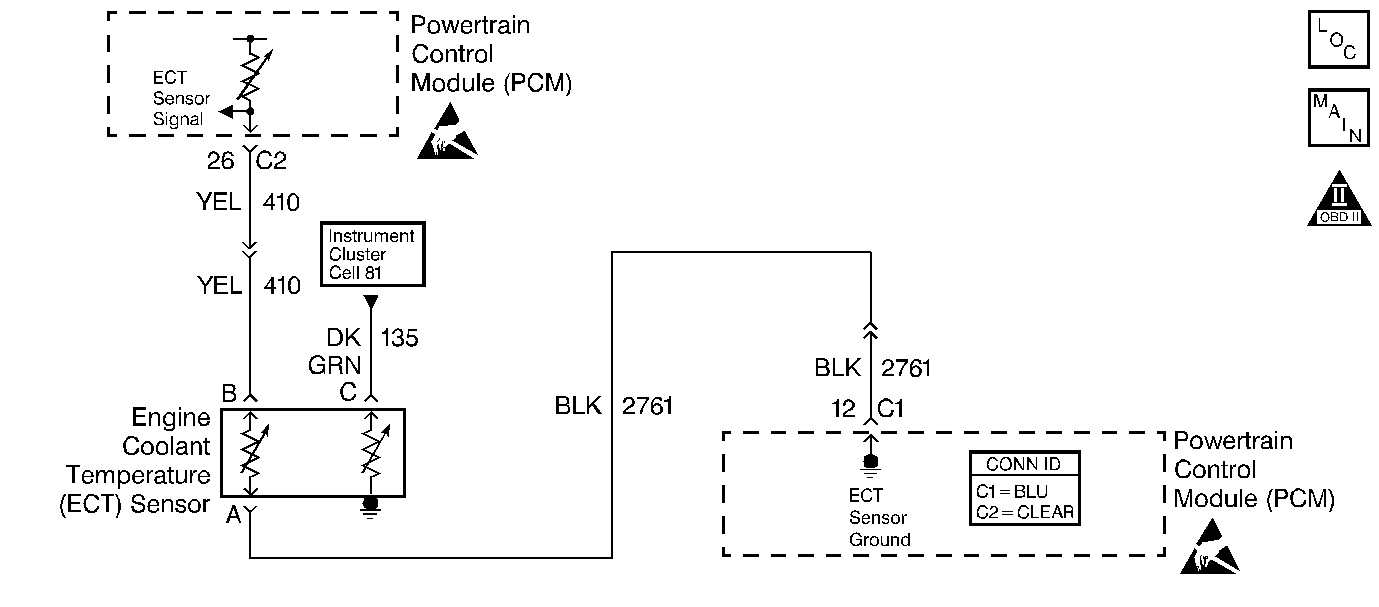
Circuit Description
The Engine Coolant Temperature (ECT) sensor is a thermistor mounted in the engine coolant stream. The PCM applies a voltage (about 5.0 volts) through a pull up resistor to the ECT signal circuit. When the engine coolant is cold, the sensor (thermistor) resistance is high, therefore the PCM will measure a high signal voltage. As the engine coolant warms, the sensor resistance becomes less, and the ECT signal voltage measured at the PCM drops. With a fully warmed up engine, the ECT signal voltage should measure about 1.5 to 2.0 volts. DTC P0118 will set when the PCM detects an excessively high signal voltage on the engine coolant temperature sensor signal circuit.
Conditions for Running the DTC
Engine run time longer than 15 seconds
Conditions for Setting the DTC
| • | The ECT sensor signal indicates an engine coolant temperature less than -34°C (-30°F). |
| • | Above condition present for at least 10 seconds. |
Action Taken When the DTC Sets
| • | The PCM will illuminate the MIL during the second consecutive trip in which the diagnostic test has been run and failed. |
| • | The PCM will store conditions which were present when the DTC set as Freeze Frame and Fail Records data. |
Conditions for Clearing the MIL/DTC
| • | The PCM will turn the MIL OFF during the third consecutive trip in which the diagnostic has been run and passed. |
| • | The history DTC will clear after 40 consecutive warm-up cycles have occurred without a malfunction. |
| • | The DTC can be cleared by using the scan tool Clear Info function or by disconnecting the PCM battery feed. |
Diagnostic Aids
Check for the following conditions:
| • | Poor connection at PCM. |
| Inspect harness connectors for backed out terminals, improper mating, broken locks, improperly formed or damaged terminals, and poor terminal to wire connection. |
| • | Damaged harness. |
| Inspect the wiring harness for damage. If the harness appears to be OK, observe the ECT display on the scan tool while moving connectors and wiring harnesses related to the ECT sensor. A change in the ECT display will indicate the location of the malfunction. |
| • | Skewed or mis-scaled ECT Sensor. |
| Refer to Temperature Versus Resistance . |
If DTC P0118 cannot be duplicated, the information included in the Fail Records data can be useful in determining vehicle mileage since the DTC was last set. If it is determined that the DTC occurs intermittently, performing the DTC P1115 Diagnostic Chart may isolate the cause of the malfunction.
Test Description
Number(s) below refer to the step number(s) on the Diagnostic Table:
-
Verifies that the malfunction is present.
-
If DTC P0118 can be repeated only by duplicating the Fail Records conditions, refer to the Temperature Versus Resistance
-
This vehicle is equipped with a PCM which utilizes an Electrically Erasable Programmable Read Only Memory (EEPROM). When the PCM is being replaced, the new PCM must be programmed.
Step | Action | Value(s) | Yes | No |
|---|---|---|---|---|
1 | Was the Powertrain On-Board Diagnostic (OBD) System Check performed? | -- | ||
Is ECT less than the specified value? | -38°C (-36°F) | |||
Does the scan tool indicate DTC P0118 failed? | -- | Go to Diagnostic Aids | ||
4 |
Was a problem found? | -- | ||
5 |
Is ECT at the specified value? | 140°C (284°F) | ||
6 |
Is ECT at the specified value? | 140°C (284°F) | ||
7 |
Was a problem found? | -- | ||
8 |
Was a problem found? | -- | ||
9 |
Was a problem found? | -- | ||
10 |
Was a problem found? | -- | ||
11 | Replace the ECT sensor. Refer to Engine Coolant Temperature Sensor Replacement . Is action complete? | -- | -- | |
|
Important: The replacement PCM must be programmed. Refer to Powertrain Control Module Replacement/Programming Replace the PCM. Is action complete? | -- | -- | ||
13 |
Does the scan tool indicate DTC P0118 failed? | -- | System OK |
